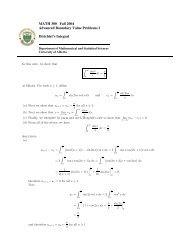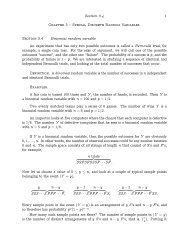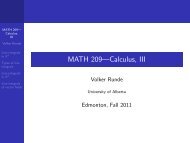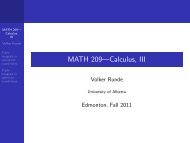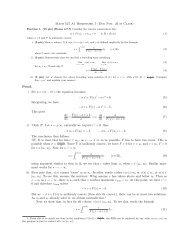Math 411: Honours Complex Variables - University of Alberta
Math 411: Honours Complex Variables - University of Alberta
Math 411: Honours Complex Variables - University of Alberta
Create successful ePaper yourself
Turn your PDF publications into a flip-book with our unique Google optimized e-Paper software.
44 CHAPTER 6. CONVERGENCE OF HOLOMORPHIC FUNCTIONS<br />
Pro<strong>of</strong>. If γ : [a,b] → C is a curve (and thus continuous) then {γ} = γ([a,b]) is<br />
compact. Hence, Lemma 6.1 applies.<br />
Theorem 6.2 (Weierstraß Theorem). Let D ⊂ C be open, let f1,f2,... : D → C<br />
converges to f : D → C compactly. Then f is<br />
be holomorphic such that (fn) ∞ n=1<br />
holomorphic, and (f (k)<br />
n ) ∞ n=1 converges compactly to f (k) for each k ∈ N.<br />
Pro<strong>of</strong>. By Theorem 6.1, f is continuous.<br />
�<br />
To see that f is holomorphic, let ∆ ⊂ D be a triangle. By Goursat’s Lemma,<br />
∂∆fn(ζ)dζ = 0 holds for all n ∈ N. From Lemma 6.2, we conclude that<br />
� �<br />
f(ζ)dζ = lim fn(ζ)dζ = 0,<br />
n→∞<br />
∂∆<br />
i.e. f satisfies the Morera condition and thus is holomorphic.<br />
Let z0 ∈ D, and let 0 < r < R be such that Br[z0] ⊂ BR(z0) ⊂ BR[z0] ⊂ D. For<br />
any z ∈ Br(z0), we have<br />
|f ′ n (z)−f′ (z)| = 1<br />
2π<br />
Let ǫ > 0, and choose N ∈ N such that<br />
∂∆<br />
��<br />
�<br />
�<br />
fn(ζ)−f(ζ)<br />
�<br />
∂BR(z0) (ζ −z) 2<br />
�<br />
�<br />
dζ�<br />
�<br />
≤ 1<br />
2π ℓ(∂BR(z0))<br />
�<br />
�<br />
sup �<br />
fn(ζ)−f(ζ)<br />
� (ζ −z) 2<br />
�<br />
�<br />
�<br />
�<br />
≤<br />
ζ∈∂BR(z0)<br />
R<br />
(R−r) 2<br />
sup |fn(ζ)−f(ζ)|.<br />
ζ∈∂BR(z0)<br />
|fn(ζ)−f(ζ)|< ǫ (R−r)2<br />
R<br />
for all n ≥ N and ζ ∈ ∂BR(z0). Then it follows from the above estimates that<br />
|f ′ n (z)−f′ (z)|≤ ǫforall n ≥ N andz ∈ Br(z0). Consequently, (f ′ n |Br(z0)) ∞ n=1 converges<br />
to f ′ |Br(z0) uniformly on Br(z0). As z0 ∈ D is arbitrary, this means that (f ′ n) ∞ n=1<br />
converges to f locally uniformly, i.e. compactly, on D.<br />
For higher derivatives, the claim now follows by induction.<br />
Lemma 6.3. Let z0 ∈ C, let r > 0, and let z ∈ Br(z0). Then<br />
1<br />
ζ −z =<br />
∞�<br />
n=0<br />
converges absolutely and uniformly on ∂Br(z0).<br />
1 n<br />
(ζ −z0) n+1(z −z0)



